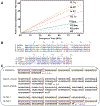Protamines and the sperm nuclear basic proteins Pandora's Box of insects
- PMID: 38408323
- PMCID: PMC12216123
- DOI: 10.1139/bcb-2023-0363
Protamines and the sperm nuclear basic proteins Pandora's Box of insects
Abstract
Insects are the largest group of animals when it comes to the number and diversity of species. Yet, with the exception of Drosophila, no information is currently available on the primary structure of their sperm nuclear basic proteins (SNBPs). This paper represents the first attempt in this regard and provides information about six species of Neoptera: Poecillimon thessalicus, Graptosaltria nigrofuscata, Apis mellifera, Nasonia vitripennis, Parachauliodes continentalis, and Tribolium castaneum. The SNBPs of these species were characterized by acetic acid urea gel electrophoresis (AU-PAGE) and high-performance liquid chromatography fractionated. Protein sequencing was obtained using a combination of mass spectrometry sequencing, Edman N-terminal degradation sequencing and genome mining. While the SNBPs of several of these species exhibit a canonical arginine-rich protamine nature, a few of them exhibit a protamine-like composition. They appear to be the products of extensive cleavage processing from a precursor protein which are sometimes further processed by other post-translational modifications that are likely involved in the chromatin transitions observed during spermiogenesis in these organisms.
Keywords: insects; mass spectrometry/Edman N-terminal sequencing; protamines; sperm nuclear basic proteins (SNBPs).
© 2024 The Author(s). This work is licensed under a Creative Commons Attribution 4.0 International License (CC BY 4.0), which permits unrestricted use, distribution, and reproduction in any medium, provided the original author(s) and source are credited.
Conflict of interest statement
All authors have read and agreed to the published version of the manuscript and there is no conflict of interest, including specific financial interest and relationships and affiliations relevant to the subject of the manuscript.
Figures








Similar articles
-
A rapid and systematic review of the clinical effectiveness and cost-effectiveness of paclitaxel, docetaxel, gemcitabine and vinorelbine in non-small-cell lung cancer.Health Technol Assess. 2001;5(32):1-195. doi: 10.3310/hta5320. Health Technol Assess. 2001. PMID: 12065068
-
A haystack in the needle: packaging sperm DNA in insects.Curr Opin Genet Dev. 2025 Aug;93:102378. doi: 10.1016/j.gde.2025.102378. Epub 2025 Jul 7. Curr Opin Genet Dev. 2025. PMID: 40627886 Review.
-
Intravenous magnesium sulphate and sotalol for prevention of atrial fibrillation after coronary artery bypass surgery: a systematic review and economic evaluation.Health Technol Assess. 2008 Jun;12(28):iii-iv, ix-95. doi: 10.3310/hta12280. Health Technol Assess. 2008. PMID: 18547499
-
Home treatment for mental health problems: a systematic review.Health Technol Assess. 2001;5(15):1-139. doi: 10.3310/hta5150. Health Technol Assess. 2001. PMID: 11532236
-
How lived experiences of illness trajectories, burdens of treatment, and social inequalities shape service user and caregiver participation in health and social care: a theory-informed qualitative evidence synthesis.Health Soc Care Deliv Res. 2025 Jun;13(24):1-120. doi: 10.3310/HGTQ8159. Health Soc Care Deliv Res. 2025. PMID: 40548558
Cited by
-
The protamines of the noble false widow spider Steatoda nobilis provide an example of liquid-liquid phase separation chromatin transitions during spermiogenesis.bioRxiv [Preprint]. 2024 Jun 5:2024.06.04.597381. doi: 10.1101/2024.06.04.597381. bioRxiv. 2024. Update in: Development. 2024 Nov 15;151(22):dev203134. doi: 10.1242/dev.203134. PMID: 38895387 Free PMC article. Updated. Preprint.
-
The protamines of the spider Steatoda sp. provide an example of liquid-liquid phase separation chromatin transitions during spermiogenesis.Development. 2024 Nov 15;151(22):dev203134. doi: 10.1242/dev.203134. Epub 2024 Nov 18. Development. 2024. PMID: 39465422 Free PMC article.
References
-
- Alvi ZA, Chu TC, Schawaroch V, and Klaus AV 2013. Protamine-like proteins in 12 sequenced species of Drosophila. Protein Pept. Lett. 20(1): 17–35. Available from https://www.ncbi.nlm.nih.gov/pubmed/22789106. doi: 10.2174/092986613804096847. - DOI - PubMed
-
- Ando T, Yamasaki M, and Suzuki K 1973. Protamines: isolation, characterization and function. Springer-Verlag, NY. - PubMed
-
- Ausió J 1992. Presence of a highly specific histone H1-like protein in the chromatin of the sperm of the bivalve mollusks. Mol. Cell. Biochem. 115(2): 163–172. Available from http://research.bmn.com/medline/search/record?uid=MDLN.93078720. doi: 10.1007/BF00230327. - DOI - PubMed
-
- Ausió J 1995. Histone H1 and the evolution of the nuclear sperm specific proteins. Memoires de Museum National d’Histoire Naturelle, Paris.
Publication types
MeSH terms
Substances
Grants and funding
LinkOut - more resources
Full Text Sources

